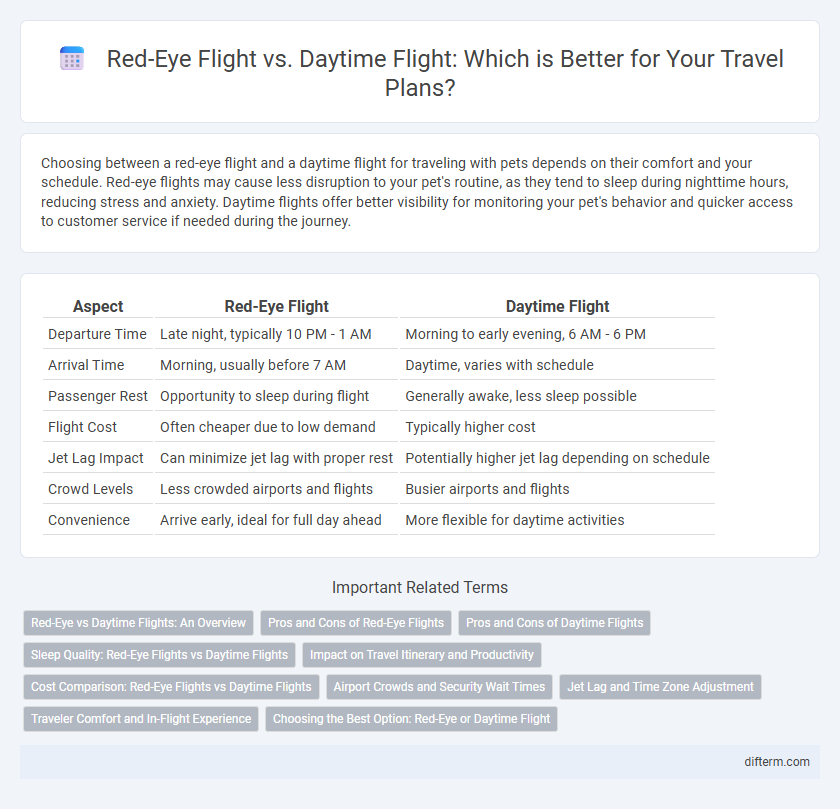Choosing between a red-eye flight and a daytime flight for traveling with pets depends on their comfort and your schedule. Red-eye flights may cause less disruption to your pet's routine, as they tend to sleep during nighttime hours, reducing stress and anxiety. Daytime flights offer better visibility for monitoring your pet's behavior and quicker access to customer service if needed during the journey.
Table of Comparison
| Aspect | Red-Eye Flight | Daytime Flight |
|---|---|---|
| Departure Time | Late night, typically 10 PM - 1 AM | Morning to early evening, 6 AM - 6 PM |
| Arrival Time | Morning, usually before 7 AM | Daytime, varies with schedule |
| Passenger Rest | Opportunity to sleep during flight | Generally awake, less sleep possible |
| Flight Cost | Often cheaper due to low demand | Typically higher cost |
| Jet Lag Impact | Can minimize jet lag with proper rest | Potentially higher jet lag depending on schedule |
| Crowd Levels | Less crowded airports and flights | Busier airports and flights |
| Convenience | Arrive early, ideal for full day ahead | More flexible for daytime activities |
Red-Eye vs Daytime Flights: An Overview
Red-eye flights typically depart late at night and arrive early morning, allowing travelers to maximize daytime hours at their destination. Daytime flights offer the advantage of natural light for better visibility and often smoother airport services. Comparing red-eye versus daytime flights, considerations include sleep disruption, airport congestion, and potential cost differences.
Pros and Cons of Red-Eye Flights
Red-eye flights offer the advantage of maximizing daytime hours at the destination, useful for business travelers or short trips, and often come with lower ticket prices compared to daytime flights. However, these overnight flights can cause significant fatigue and disrupt circadian rhythms, leading to reduced productivity and increased jet lag upon arrival. Passengers should weigh the convenience of uninterrupted travel time against the potential physical toll when choosing between red-eye and daytime flights.
Pros and Cons of Daytime Flights
Daytime flights offer the advantage of easier airport navigation due to fully operational services and better visibility during travel. Passengers often find daytime flights more comfortable for adjusting to new time zones as they remain awake and active, reducing jet lag symptoms. However, daytime flights can be more expensive and crowded, with increased chances of delays compared to red-eye flights.
Sleep Quality: Red-Eye Flights vs Daytime Flights
Red-eye flights often disrupt sleep quality due to limited space, noise, and cabin lighting, resulting in fragmented and shorter rest periods. Daytime flights generally allow travelers to stay awake and align with natural circadian rhythms, promoting better overall alertness upon arrival. Choosing daytime flights can reduce fatigue and improve performance during subsequent activities or meetings.
Impact on Travel Itinerary and Productivity
Red-eye flights often maximize daytime productivity by allowing travelers to sleep during transit and arrive early at their destination, optimizing tight schedules. Daytime flights, while more comfortable and conducive to adjusting circadian rhythms, can consume valuable daytime hours and reduce overall efficiency. Choosing between red-eye and daytime flights depends on balancing the need for rest with maintaining peak productivity throughout the travel itinerary.
Cost Comparison: Red-Eye Flights vs Daytime Flights
Red-eye flights typically offer lower prices compared to daytime flights due to reduced demand during late-night hours, making them a budget-friendly option for travelers. Airlines often capitalize on this by offering promotional fares on overnight routes to maximize aircraft utilization and fill seats. However, daytime flights tend to have higher costs associated with increased passenger comfort and convenience, impacting overall pricing strategies.
Airport Crowds and Security Wait Times
Red-eye flights typically experience lighter airport crowds and shorter security wait times compared to daytime flights, facilitating a quicker and less stressful travel process. Daytime flights often coincide with peak travel hours, resulting in crowded terminals and longer security lines. Choosing red-eye options can optimize time efficiency for travelers seeking to avoid congestion and expedite airport procedures.
Jet Lag and Time Zone Adjustment
Red-eye flights often cause more severe jet lag due to disrupted sleep patterns and limited rest during nighttime travel, making time zone adjustment harder. Daytime flights, by aligning travel with natural daylight hours, help passengers maintain circadian rhythms and reduce fatigue upon arrival. Effective time zone adjustment depends on exposure to natural light and gradual sleep schedule shifts, favoring daytime flights for smoother adaptation.
Traveler Comfort and In-Flight Experience
Red-eye flights often offer fewer crowds and quieter cabins, enhancing traveler comfort for those seeking a restful journey, though limited meal and service options can impact the overall in-flight experience. Daytime flights provide more active service with full meal options and better lighting, allowing for easier movement and entertainment access, which improves comfort for passengers who prefer engagement over rest. Choosing between red-eye and daytime flights depends on individual preferences for sleep quality and in-flight amenities.
Choosing the Best Option: Red-Eye or Daytime Flight
Red-eye flights offer the advantage of maximizing daytime hours at the destination and often come with lower ticket prices, making them ideal for budget-conscious travelers or those with tight schedules. Daytime flights provide better comfort and convenience, reducing the risk of fatigue and allowing easier adjustment to new time zones, which benefits business travelers and families. Evaluating factors such as personal sleep patterns, destination time zone, and trip purpose can help determine whether a red-eye or daytime flight best meets individual travel needs.
red-eye flight vs daytime flight Infographic

 difterm.com
difterm.com